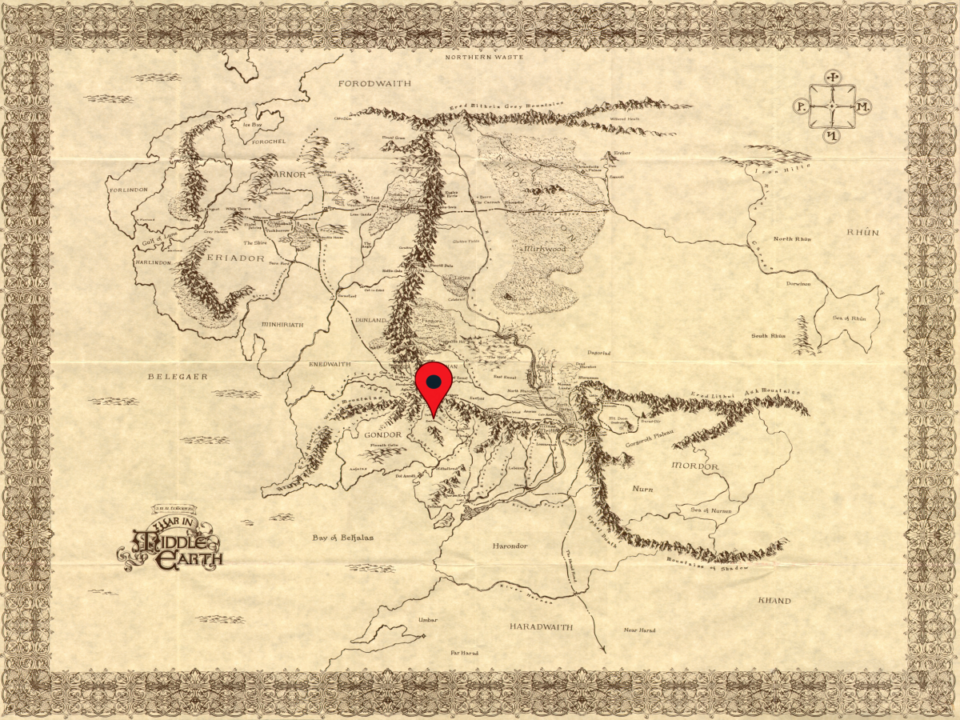Welcome back to everyone’s favorite www.isleyunruh.com Monday feature! Middle-earth being the place of enchantment and wonder that it is, each month I will use my love of fictional cartography to transport you to another time and place. So why not take a moment to fill your head full of knowledge that will have no bearing at all on the real world?
This month I’ll take a look at a seemingly minor pass in a minor spur of the White Mountains.
But when the dawn came, cold and pale, Aragorn rose at once, and he led the Company forth upon the journey of greatest haste and weariness that any among them had known, save he alone, and only his will held them to go on. No other mortal Men could have endured it, none but the Dúnedain of the North, and with them Gimli the Dwarf and Legolas of the Elves.
They passed Tarlang’s Neck and came into Lamedon; and the Shadow Host pressed behind and fear went on before them, until they came to Calembel upon Ciril, and the sun went down like blood behind Pinnath Gelin away in the West behind them. The township and the fords of Ciril they found deserted, for many men had gone away to war, and all that were left fled to the hills at the rumour of the coming of the King of the Dead. But the next day there came no dawn, and the Grey Company passed on into the darkness of the Storm of Mordor and were lost to mortal sight; but the Dead followed them.
The white mountains that separated Rohan from the Southern lands of Gondor had many outlying spurs and offshoot peaks, especially upon their southern slopes. Today, I will discuss one such range, the long (100 miles) ridge that swept southwards between the rivers Ciril and Morthond.
By the time of The War of the Ring, the word “Tarlang” had become a commonly used name, which led to some rumors that the low pass that cut into the ridge that swept south out of the White Mountains was the neck of a once mighty giant who had also gone by that name. Some even claimed to know the names of three peaks that swept up from the ridge, calling them Cûl Veleg and Cûl Bîn, the load that the giant Torlang was carrying before he tripped and broke his neck with his head forming the third peak, Dol Tarlang. Of course, sensible folk would scoff at a giant with a 100 mile long head, and thus such stories (along with the peaks named in them) are of doubtful merit at best.
Whatever the geologic reason, the ridge crumbled away into low lying hills before sweeping up into the white mountains proper at their base, and thus a road was built through the lowest point which had taken on the name Tarlang’s Neck. This road stretched from the Vale of Erech, through Lamedon, and all the way down to Pelargir upon the banks of the mighty Anduin.
Without this natural pass to allow travelers through the Tarlang ridge, the Grey Company, already pushed to the limits of their almost superhuman endurance, would have been set back at least 50 miles in their journey to roust the Easterling hordes that assailed Pelargir. Who knows what might have happened had they been forced to detour around the Tarlang ridge. Perhaps the fords of Linhir would have fallen, or even worse, the Corsairs may have already headed upriver to add their forces to the battle of the Pelennor fields that was already dangerously close to being carried by the forces of Mordor.
It may seem but a small and insignificant pass, however, no place in Middle-earth is without its own important moment in the rich and varied history of a land that has seen so much in its thousands of years of existence.


Leave A Reply